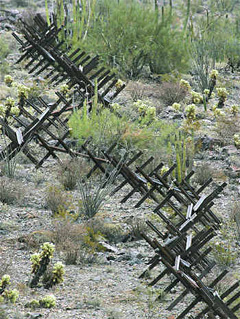 |
 |
 |
 News from Around the Americas | May 2007 News from Around the Americas | May 2007  
Barriers at Border Aimed at Smugglers
 BYLINE BYLINE


| | The barricades at Organ Pipe National Monument in Arizona are part of the 200-mile line of barriers going up at the U.S.-Mexico border. Officials say they won't stop illegal immigrants or drug runners on foot but might slow them down and make them easier to catch. (AP) |
Organ Pipe Cactus National Monument, Ariz. – Two hundred miles of vehicle barriers made of concrete, steel poles and train tracks are being erected across the Southwestern desert to thwart smugglers trying to bring illegal immigrants or drugs into the country in vans, SUVs and trucks.

Smugglers commonly drive people and marijuana over the Mexican border, using roads that have been illegally cut across remote sections of the vast desert.

Authorities concede the vehicle barriers won't deter people on foot, whether illegal immigrants or backpacking drug runners. But the obstacles might slow them down and make them easier to catch as they hike across miles of rocky, hilly terrain.

The barrier construction is being overseen by a combination of federal agencies at a cost of tens of millions of dollars.

The obstructions include bollards, which are concrete-filled steel poles poking out of the ground at staggered heights; railroad rails welded horizontally onto concrete-reinforced steel posts; and X-shaped rail barricades weighing up to 1,400 pounds.

The barriers are in addition to the border fences meant to stop pedestrians in more populated areas such as the Arizona communities of Douglas and Nogales.

The lines of barriers have been going up for years as authorities have looked for ways to stop the influx of illegal immigrants into the four states along the Mexican border. Arizona's 377-mile border is the busiest segment for illegal entries.

Already, about 80 miles of vehicle barriers are in place along the U.S.-Mexico border. Authorities look to have a total of 200 miles of barriers in place, mostly in Arizona and New Mexico, by the end of next year.

At Organ Pipe Cactus National Monument, the barriers – put up along 29 miles of the park's southern boundary at a cost of $14 million – were a response to the 2002 killing of a park ranger by criminals fleeing Mexican authorities.

"It's eliminated the vast majority of the vehicular smuggling that was taking place before," said Chief Ranger Fred Patton.

Smugglers and other criminals can still go around the Organ Pipe barriers to the east and west and drive in through other isolated stretches of the border.

But authorities are optimistic about what they will be able to do to stop the illegal traffic once more barriers are erected across the landscape. | 
 | |
 |



